CO2 Injection via a Horizontal Well into the Coal Seam at the Experimental Mine Barbara in Poland
Abstract
1. Introduction
2. Materials and Methods
2.1. Site Characterization
2.1.1. Geological Data
2.1.2. Coal Properties
- specific surface area according to D-A—130.89 m2/g;
- pores volume—0.049 cm3/g;
- porosity—7.6%;
- pore size distribution—see File S1.
2.1.3. Establishing Background CO2 Concentration in Soil Gas
2.2. Experimental Procedure
2.2.1. Carbon Dioxide Injection—Stage I
- Setting 1—1.5 bar;
- Setting 2—3.0 bar;
- Setting 3—10.5 bar.
2.2.2. Carbon Dioxide Injection—Stage II
2.2.3. Carbon Dioxide Injection—Stage III
2.3. Monitoring System
2.3.1. Near-Surface Monitoring
- E—gas flux [kg m−2s−1]
- dm—mass of gas flowing through the surface F over time dt [kg]
- ρ—CO2 density under measurement conditions [kg m−3]
- ρn—CO2 density under normal conditions [1.977 kg mn−3]
- Vk—active volume of the accumulation chamber [m3]
- F—surface area through which gas flows into the accumulation chamber [m2]
- P—atmospheric pressure during gas measurement [bar]
- Pn—normal pressure [1.01325 bar]
- Tn—normal temperature [273.15 K]
- T—temperature during gas measurement [K]
- dc—change in the volumetric concentration of gas in the chamber over time dt [%vol]
- dt—time increment [s]
2.3.2. Deep Monitoring Wells
2.3.3. Mine Monitoring
2.4. Injection System
- Inlet of the installation (P1);
- Before the main valve of the injection well (P2);
- After the main valve, inside the injection well (P2_2).
3. Results
3.1. Stage I
3.2. Stage II
3.3. Stage III
4. Discussion
- —change in brine and gas density at reservoir conditions, kg/m3;
- —velocity in a porous medium, m/s;
- —gravitational acceleration, m/s2;
- —vertical permeability of the rock, m2;
- —coefficient of dynamic viscosity, Pa∗s.
- —thickness of the layer, m;
- —coefficient of effective porosity, [-].
5. Conclusions
- Implementations should be preceded by extensive geological studies to support the proper design of the injection installation. With well-known geological information, it is possible to further enhance the design by supportive numerical modeling, which allows for the simulation of the injection process and obtaining insights on the feasible process conditions, including maximum pressures, injection rates, the total injected yield, etc.
- The designed installation should allow for high flexibility in terms of the potential process conditions. Even if properly geologically researched and simulated, the final injection parameters may differ significantly from what was originally expected. The predicted values of process pressure, temperature, gas mass flow, etc., should constitute the basis for designing the nominal parameters of the installation’ components, but each sensor and controller should allow for the highest available range of measurement and control, respectively.
- The installation should allow for the monitoring of the most significant parameters, such as pressure, temperature, and the mass flow of the CO2 injected. These parameters are crucial for monitoring and quantifying the processes, including the operational safety (e.g., spotting leakage from the pipelines in the mine workings).
- Depending on the circumstances, the horizontal injection well can be drilled either from the surface, with the use of directional drilling, or from existing mining workings (as was the case in the ROCCS project). In the latter case, it is important to seal the first few dozen meters of the borehole (via a casing pipe and cementing) to ensure that the injected CO2 does not migrate into the mine workings.
- The drilling process needs to be carried out cautiously to mitigate coal seam fracturing, potentially resulting in reduced caprock integrity, especially in the case of low-thickness coal seams. Such fractures can promote the creation of preferential pathways or enlarge existing ones. This can lead to CO2 leakage into the overburden and to the surface.
- If there is no steady pressure buildup during injection, it could be an indicator of potential CO2 leakage. A preferential horizontal migration pathway could exist without any surface leakage. However, if the monitoring system also supports the leakage scenario, the injection process in the specific well should be terminated, as there are no countermeasures to fix a compromised injection well/coal seam area.
- Typically, to prevent gas leakage, CO2 should be injected at a pressure proportional to the hydrostatic pressure found in the coal seam, which is approximately 1 bar for every 10 m of depth. In the case of a water-saturated coal seam, other factors come into play, such as overcoming capillary entry pressures and managing pressure buildup due to variations in permeability. Consequently, the required injection pressure will need to be significantly higher.
Supplementary Materials
Author Contributions
Funding
Data Availability Statement
Conflicts of Interest
References
- IPCC. Summary for Policymakers. In Global Warming of 1.5 °C; An IPCC Special Report; IPCC: Geneva, Switzerland; World Meteorological Organization: Geneva, Switzerland, 2018; p. 32. ISBN 978-92-9169-151-7. [Google Scholar]
- EU Green Deal. Communication from the Commission to the European Parliament, the European Council, the Council, the European Economic and Social Committee and the Committee of the Regions, 2019. Available online: https://ec.europa.eu/info/strategy/priorities-2019-2024/european-green-deal_en#documents (accessed on 15 August 2023).
- Bruhn, T.H.; Naims, H.; Olfe-Kräutlein, B. Separating the debate on CO2 utilisation from carbon capture and storage. Environ. Sci. Policy 2016, 60, 38–43. [Google Scholar] [CrossRef]
- CCS Institute. Targeting Climate Change. The Global Status of CCS: 2019; CCS Institute: Melbourne, Australia, 2019. [Google Scholar]
- Vangkilde-Pedersen, T.; Anthonsen, K.L.; Smith, N.; Kirk, K.; Neele, F.; van der Meer, B.; Le Gallo, Y.; Bossie-Codreanu, D.; Wojcicki, A.; Le Nindre, Y.-M.; et al. Assessing European capacity for geological storage of carbon dioxide–the EU GeoCapacity project. Energy Procedia 2009, 1, 2663–2670. [Google Scholar] [CrossRef]
- Bachu, S. Screening and Ranking Sedimentary Basins for Sequestration of CO2 in Geological Media in Response to Climate Change. Environ. Earth Sci. 2003, 44, 277–289. [Google Scholar] [CrossRef]
- Stevens, S.H.; Spector, D.; Riemer, P. Enhanced Coalbed Methane Recovery and CO2 Sequestration. J. Pet. Technol. 2001, 53, 84–89. [Google Scholar] [CrossRef]
- Bromhal, G.; Sams, W.N.; Jikich, S.A.; Ertekin, T.; Smith, D.H. Simulation of CO2 Sequestration in Coal Beds: The Effects of Sorption Isotherms. Chem. Geol. 2005, 217, 201–211. [Google Scholar] [CrossRef]
- Sams, W.N.; Bromhal, G.; Jikich, S.A.; Ertekin, T.; Smith, D.H. Field Project Designs for Carbon Dioxide Sequestration and Enhanced Coalbed Methane Production. Energy Fuels 2005, 19, 2287. [Google Scholar] [CrossRef]
- Remner, D.J.; Ertekin, T.; Sung, W.; King, G.R. A parametric study of the effects of coal seam properties on gas drainage efficiency. SPE Reserv. Eng. 1986, 1, 633–646. [Google Scholar] [CrossRef]
- Palmer, I.; Mansoori, J. How Permeability Depends on Stress and Pore Pressure in Coalbeds: A New Model. SPE Res. Eval. Eng. 1998, 1, 539–544, SPE-52607-PA. [Google Scholar] [CrossRef]
- Anderson, J.; Bachu, S.; Nimir, H.B.; Basu, B.; Bradshaw, J.; Deguchi, G.; Gale, J.; von Goerne, G.; Heidug, W.; Holloway, S.; et al. Underground Geological Storage; Cambridge University Press: Cambridge, UK, 2005. [Google Scholar]
- Fujioka, M.; Yamaguchi, S.; Nako, M. CO2-ECBM field tests in the Ishikari Coal Basin of Japan. Int. J. Coal Geol. 2010, 82, 287–298. [Google Scholar] [CrossRef]
- White, C.M.; Smith, D.H.; Jones, K.L.; Goodman, A.L.; Jikich, S.A.; LaCount, R.B.; DuBose, S.B.; Ozdemir, E.; Morsi, B.I.; Schroeder, K.T. Sequestration of carbon dioxide in coal with enhanced coalbed methane recovery—A review. Energy Fuels 2005, 19, 659–724. [Google Scholar] [CrossRef]
- Pagnier, H.; van Bergen, F.; Krzystolik, P.; Skiba, J.; Jura, B.; Hadro, J.; Wentink, P.; De-Smedt, G.; Kretzschmar, H.-J.; Fröbel, J.; et al. Reduction of CO2 Emission by Means of CO2 Storage in Coal Seams in the Silesian Coal Basin of Poland, in TNO, RECOPOL Final Report; CORDIS: Hialeah, FL, USA, 2006. [Google Scholar]
- EU GeoCapacity. Project no. SES-518318, EU GeoCapacity, Assessing European Capacity for Geological Storage of Carbon Dioxide. Final Report; Česká Geologická služba: Staré Brno, Czech Republic, 2008. [Google Scholar]
- Koperna, G.J., Jr.; Oudinot, A.; McColpin, G.R.; Liu, N.; Heath, J.E.; Wells, A.W.; Young, G.B.C. CO2-ECBM/storage activities at the San Juan Basin’s pump Canyon test site. In Proceedings of the SPE Annual Technical Conference and Exhibition, New Orleans, LA, USA, 4–7 October 2009; Society of Petroleum Engineers: Richardson, TX, USA, 2009. [Google Scholar]
- Pan, Z.; Ye, J.; Zhou, F.; Tan, Y.; Connell, L.D.; Fan, J. CO2 storage in coal to enhance coalbed methane recovery: A review of field experiments in China. Int. Geol. Rev. 2017, 60, 754–776. [Google Scholar] [CrossRef]
- Pagnier, H.J.M.; van Bergen, F.; David, P. Results of the RECOPOL Project: Enhanced Coalbed Methane and CO2 Storage in Poland. Environ. Geosci. 2006, 13, 85–96. [Google Scholar] [CrossRef]
- van Bergen, F.; Winthaegen, P.; Pagnier, H.; Krzystolik, P.; Jura, B.; Skiba, J.; van Wageningen, N. Assessment of CO2 storage performance of the Enhanced Coalbed Methane pilot site in Kaniow. Energy Procedia 2009, 1, 3407–3414. [Google Scholar] [CrossRef][Green Version]
- van Bergen, F.; Krzystolik, P.; van Wageningen, N.; Pagnier, H.; Jura, B.; Skiba, J.; Winthaegen, P.; Kobiela, Z. Production of gas from coal seams in the Upper Silesian Coal Basin in Poland in the post-injection period of an ECBM pilot site. Int. J. Coal Geol. 2009, 77, 175–187. [Google Scholar] [CrossRef]
- Prevedel, B.; Martens, S.; Norden, B.; Henninges, J.; Freifeld, B.M. Drilling and Abandonment Preparation of CO2 storage wells—Experience from the Ketzin pilot site. Energy Procedia 2014, 63, 6067–6078. [Google Scholar] [CrossRef]
- Masoudian, M.S. Multiphysics of carbon dioxide sequestration in coalbeds: A review with a focus on geomechanical characteristics of coal. J. Rock Mech. Geotech. Eng. 2016, 8, 93–112. [Google Scholar] [CrossRef]
- Busch, A.; Gensterblum, Y. CBM and CO2-ECBM related sorption processes in coal: A review. Int. J. Coal Geol. 2011, 87, 49–71. [Google Scholar] [CrossRef]
- Harpalani, S.; Chen, G. Observations of permeability changes in coal during gas production and its effect on production behavior. In Proceedings of the SPE Eastern Regional Meeting, Lexington, KY, USA, 22–24 October 1997; Society of Petroleum Engineers: Richardson, TX, USA, 1997. [Google Scholar]
- Shi, J.Q.; Durucan, S.; Daltaban, T.S. A Numerical Study of the Mechanisms of Openhole Cavity Completions in Coalbed Methane Wells. In Proceedings of the 2nd North American Rock Mechanics Symposium, Montreal, QC, Canada, 19–21 June 1996. [Google Scholar]
- Zhang, G.; Ranjith, P.G.; Fu, X.; Li, X. Pore-fracture alteration of different rank coals: Implications for CO2 sequestration in coal. Fuel 2021, 289, 119801. [Google Scholar] [CrossRef]
- Chen, M.; Hosking, L.J.; Sandford, R.J.; Thomas, H.R. Numerical Analysis of Improvements to CO2 Injectivity in Coal Seams Through Stimulated Fracture Connection to the Injection Well. Rock Mech. Rock Eng. 2020, 53, 2887–2906. [Google Scholar] [CrossRef]
- Wetzel, M.; Otto, C.; Chen, M.; Masum, S.; Thomas, H.; Urych, T.; Bezak, B.; Kempka, T. Hydromechanical Impacts of CO2 Storage in Coal Seams of the Upper Silesian Coal Basin (Poland). Energies 2023, 16, 3279. [Google Scholar] [CrossRef]
- Karacan, C.Ö.; Okandan, E. Optimization of horizontal well patterns for improved methane recovery from coal beds. Fuel 2000, 79, 1417–1436. [Google Scholar] [CrossRef]
- Gentzis, T.; Bolen, D. The use of numerical simulation in predicting coalbed methane producibility from the Gates coals, Alberta inner Foothills, Canada: Comparison with Mannville coal CBM production in the Alberta Syncline. Int. J. Coal. Geol. 2008, 74, 215–236. [Google Scholar] [CrossRef]
- Connell, L.; Pan, Z.; Camilleri, M.; Shangzhi, M.; Down, D.; Carras, J.; Wenzhong, Z.; Xiaokang, F.; Benguang, G.; Briggs, C.; et al. Description of a CO2 enhanced coal bed methane field trial using a multi-lateral horizontal well. Int. J. Greenh. Gas Control. 2014, 26, 204–219. [Google Scholar] [CrossRef]
- Sheng, J.J. Optimization of huff-n-puff gas injection in shale oil reservoirs. Petroleum 2017, 3, 431–437. [Google Scholar] [CrossRef]
- Ren, J.; Ren, J.; Zhang, L.; Ren, S.; Lin, J.; Meng, S.; Ren, G.; Gentzis, T. Multi-branched horizontal wells for coalbed methane production: Field performance and well structure analysis. Int. J. Coal. Geol. 2014, 131, 52–64. [Google Scholar] [CrossRef]
- Zhang, J.; Feng, Q.; Zhang, X.; Hu, Q.; Wen, S.; Chen, D.; Zhai, Y.; Yan, X. Multi-fractured horizontal well for improved coalbed methane production in eastern Ordos basi, China: Field observations and numerical simulations. J. Pet. Sci. Eng. 2020, 194, 107488. [Google Scholar] [CrossRef]
- van Wageningen, W.F.; Wentinck, H.M.; Otto, C. Report and modeling of the MOVECBM field tests in Poland and Slovenia. Energy Procedia 2009, 1, 2071–2078. [Google Scholar] [CrossRef][Green Version]
- Lafortune, S.; Adelise, F.; Bentivegna, G.; Didier, C.; Farret, R.; Gombert, P.; Lagny, C.; Pokryszka, Z.; Toimil, N.C. An experimental approach to adsorption of CO2 + CH4 gas mixtures onto coal (European RFCS CARBOLAB research project). Energy Procedia 2014, 63, 5870–5878. [Google Scholar] [CrossRef]
- PN-G-04560:1998 Standard; Paliwa Stałe—Oznaczanie Zawartości Wilgoci, Części Lotnych Oraz Popiołu Analizatorem Automatycznym. Solid Fuels—Determination of Moisture, Volatile Matter and Ash by Automatic Analyzer. Polish Committee for Standardization: Warsaw, Poland, 1998. (In Polish)
- PN-G-04516:1998 Standard; Paliwa Stałe—Oznaczanie Zawartości Części Lotnych Metodą Wagową. Solid Fuels—Gravimetric Determination of Volatile Matter. Polish Committee for Standardization: Warsaw, Poland, 1998. (In Polish)
- PN-G-04584:2001 Standard; Paliwa Stałe—Oznaczanie Zawartości Siarki Całkowitej i Popiołowej Automatycznymi Analizatorami. Solid Fuels—Determination of Total and Ash Sulfur Content with Automatic Analyzers. Polish Committee for Standardization: Warsaw, Poland, 2001. (In Polish)
- PN-G-04513:1981 Standard; Paliwa Stałe—Oznaczanie Ciepła Spalania i Obliczanie Wartości Opałowej. Solid Fuels—Determination of the Calorific Value and Calorific Value Calculation. Polish Committee for Standardization: Warsaw, Poland, 1991. (In Polish)
- PN-G-04571:1998 Standard; Paliwa Stałe—Oznaczanie Zawartości Węgla, Wodoru i Azotu Automatycznymi Analizatorami—Metoda Makro. Solid Fuels—Determination of Carbon, Hydrogen and Nitrogen Content with Automatic Analyzers—Macro Method. Polish Committee for Standardization: Warsaw, Poland, 1998. (In Polish)
- RS DYNAMICS. ECOPROBE5 Specifications. 2023. Available online: https://www.rsdynamics.com/products/environmental/ecoprobe/ (accessed on 12 September 2023).
- Atkins, P. Chemia Fizyczna; Wydawnictwo PWN: Stryków, Poland, 2001. [Google Scholar]
- Chen, M.; Masum, S.; Thomas, H.R. Three-dimensional cleat scale modelling of gas transport processes in deformable fractured coal reservoirs. Gas Sci. Eng. 2023, 110, 204901. [Google Scholar] [CrossRef]
- Masum, S.A.; Sadasivam, S.; Chen, M.; Thomas, H.R. Low subcritical CO2 adsorption-desorption behavior of intact bituminous coal cores extracted from a shallow coal seam. Langmuir 2023, 39, 1548–1561. [Google Scholar] [CrossRef]
- Chen, M.; Masum, S.A.; Sadasivam, S.; Thomas, H.R.; Mitchell, A.C. Modeling gas adsorption-desorption hysteresis in energetically heterogeneous coal and shale. Energy Fuels 2023, 37, 2149–2163. [Google Scholar] [CrossRef]
- Chen, M.; Masum, S.; Thomas, H. 3D hybrid coupled dual continuum and discrete fracture model for simulation of CO2 injection into stimulated coal reservoirs with parallel implementation. Int. J. Coal Geol. 2022, 262, 104103. [Google Scholar] [CrossRef]
- Sadasivam, S.; Masum, S.; Chen, M.; Stanczyk, K.; Thomas, H. Kinetics of gas phase CO2 adsorption on bituminous coal from a shallow coal seam. Energy Fuels 2022, 36, 8360–8370. [Google Scholar] [CrossRef]
- Masum, S.; Chen, M.; Hosking, L.; Stanczyk, K.; Kapusta, K.; Thomas, H. A numerical modelling study to support design of an in-situ CO2 injection test facility using horizontal injection well in a shallow-depth coal seam. Int. J. Greenh. Gas Contol 2022, 119, 103725. [Google Scholar] [CrossRef]
- Chen, M.; Masum, S.; Sadasivam, S.; Thomas, H. Modeling Anisotropic Adsorption-Induced Coal Swelling and Stress-Dependent Anisotropic Permeability. Int. J. Rock Mech. Min. Sci. 2022, 153, 105107. [Google Scholar] [CrossRef]
- Chen, M.; Masum, S.; Thomas, H. Modeling Adsorption and Transport behavior of Gases in Moist Coal Matrix. Energy Fuels 2021, 35, 13200–13214. [Google Scholar] [CrossRef]
- Chen, M.; Masum, S.; Thomas, H. Modelling Non-isothermal Transport Behavior of Real Gas in Deformable Coal Matrix. Energy Fuels 2021, 35, 1605–1619. [Google Scholar] [CrossRef]
- Nagy, S.; Zawisza, L. Prognoza zagrożeń metanem i gazami toksycznymi w wytypowanych rejonach likwidowanych kopalń na podstawie badań modelowych. In Raport Projektu “Prognoza Skutków Wpływu Elementów Środowiska Geologicznego na Środowisko Naturalne w Związku z Likwidacją Kopalń Węgla Kamiennego”; Unpublished project report; 2004. (In Polish) [Google Scholar]
- Chećko, J. Geologiczne Aspekty Migracji Gazów Kopalnianych na Powierzchnię w Przypadku Likwidacji Kopalń Węgla Kamiennego. Unpublished Doctoral Dissertation, Główny Instytut Górnictwa, Katowice, Poland, 2007. (In Polish). [Google Scholar]


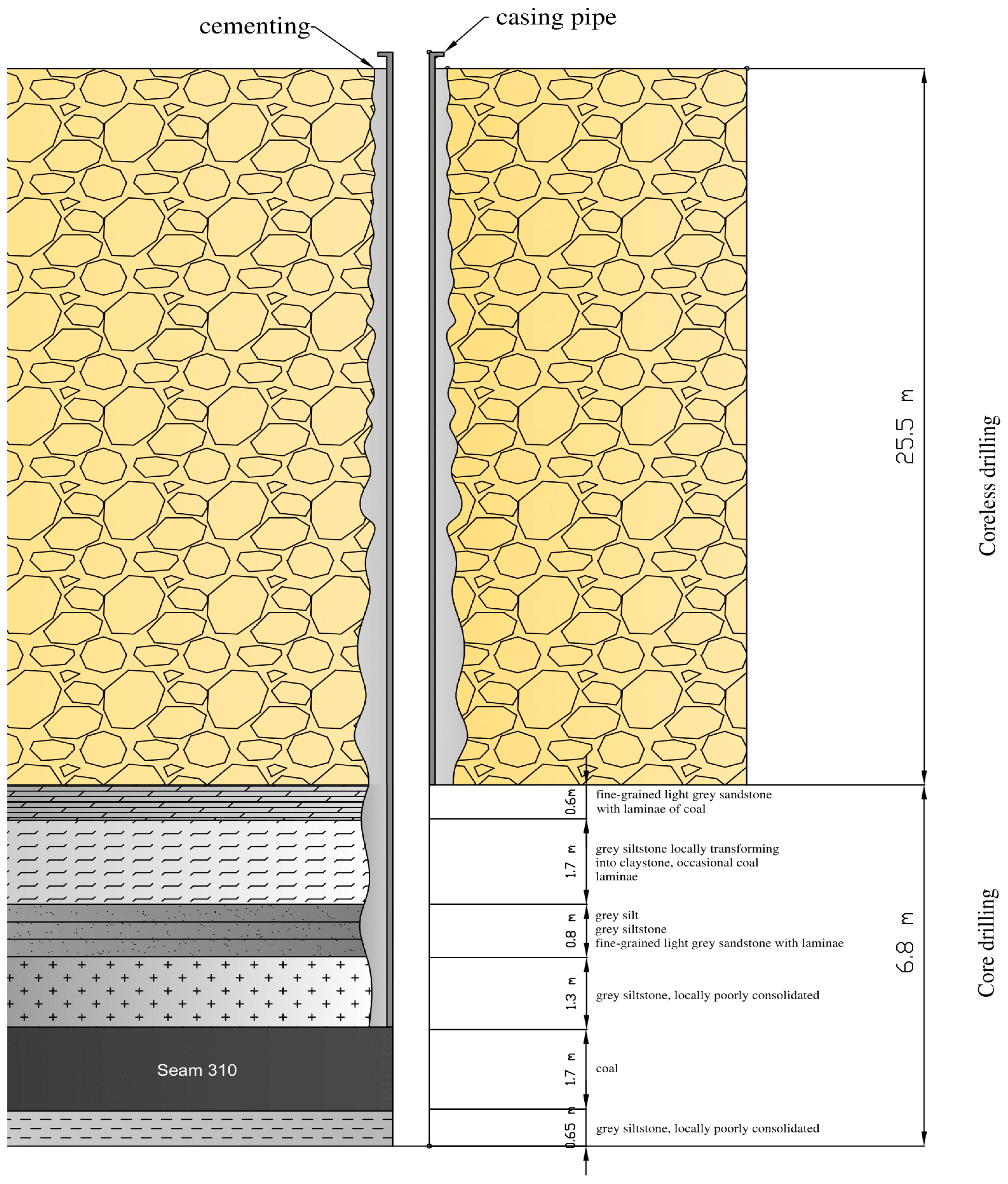

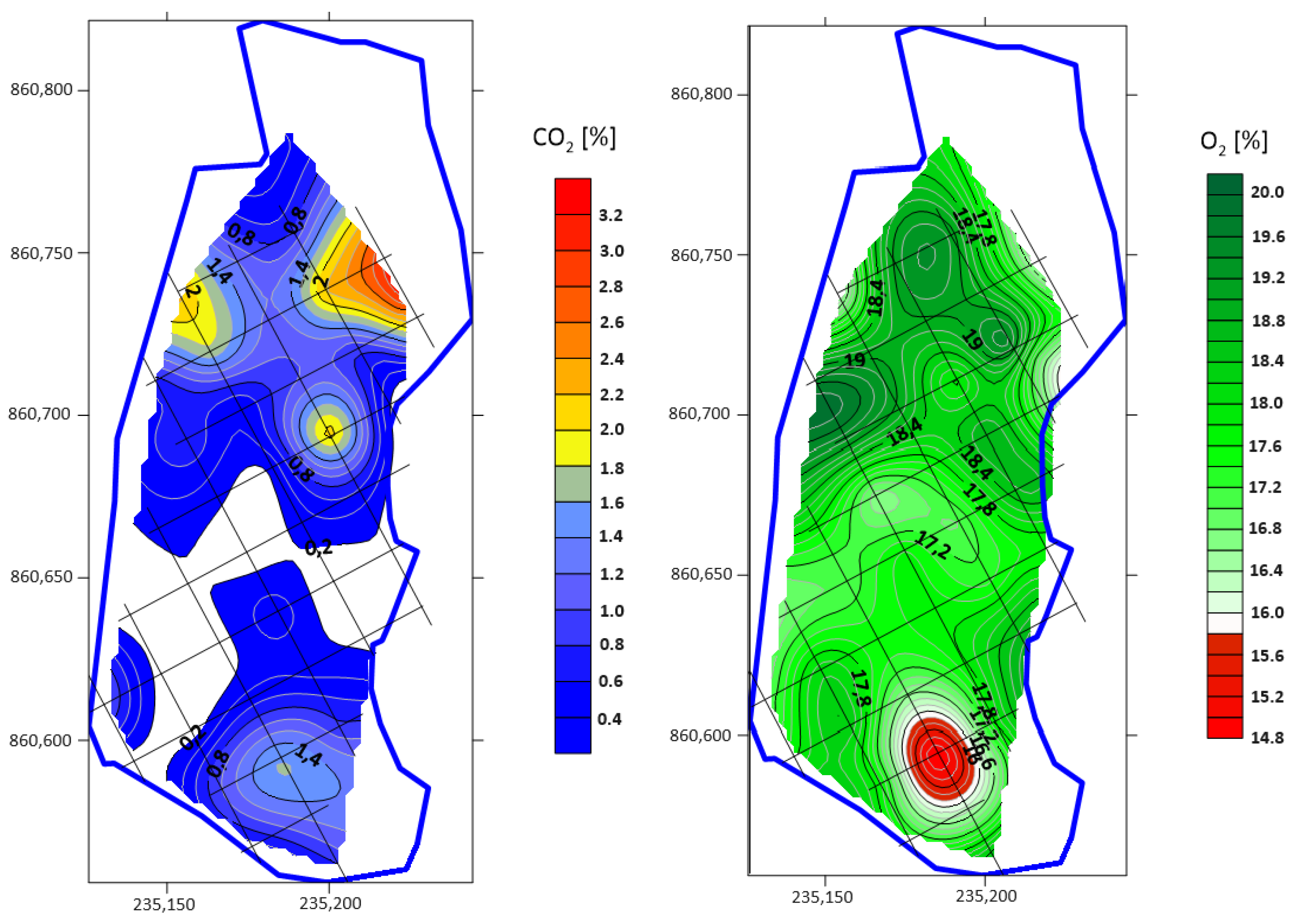


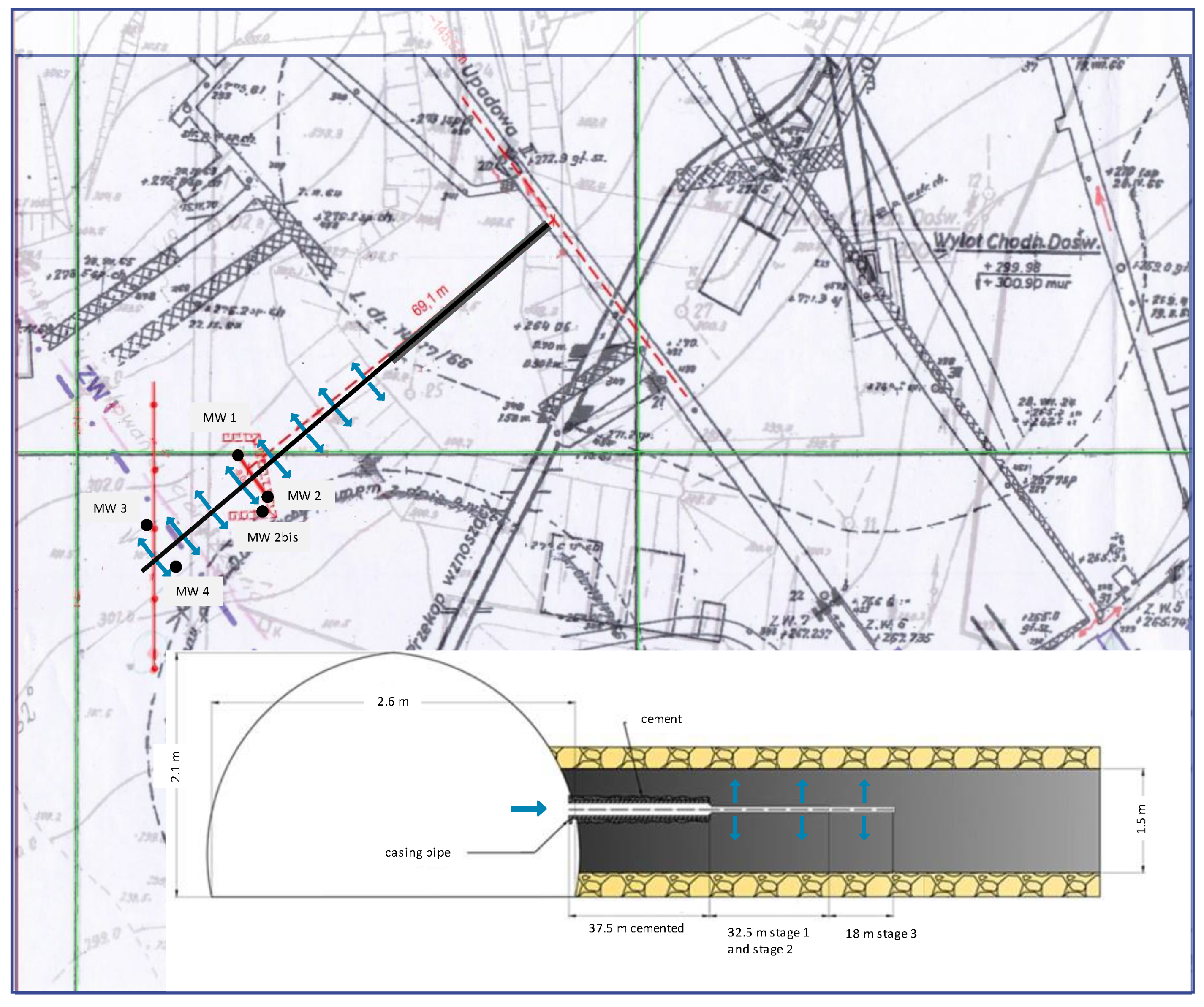





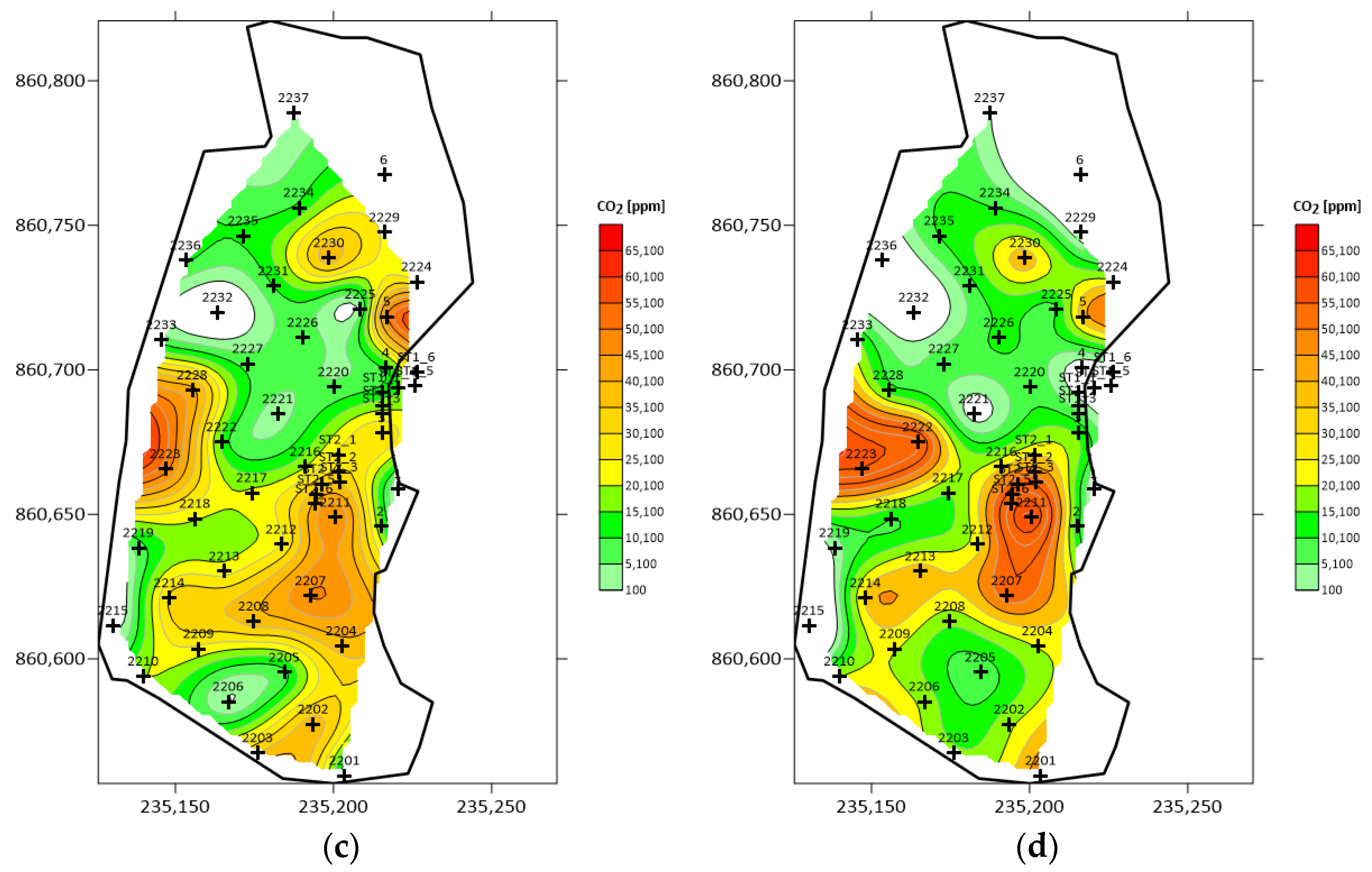



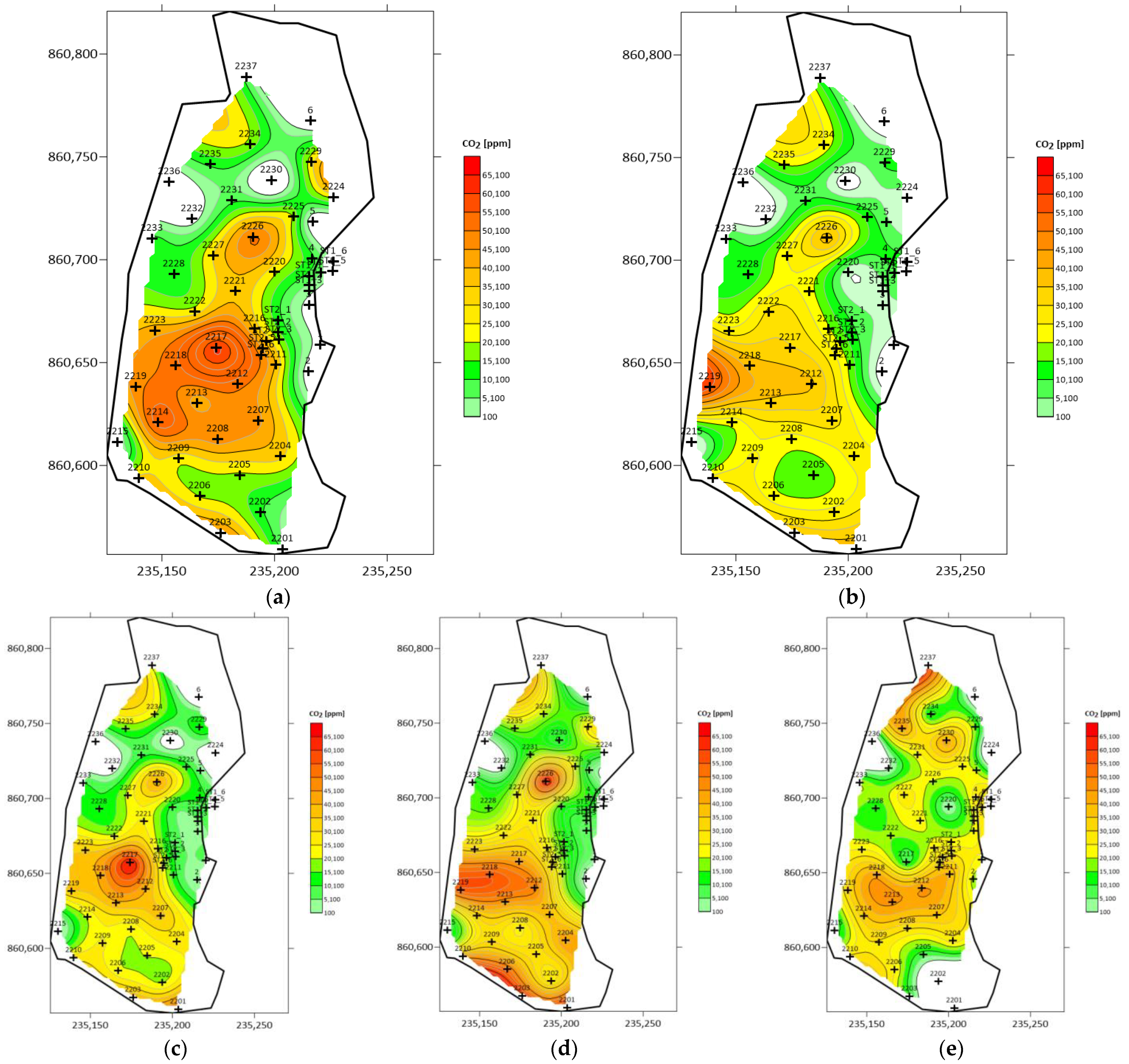

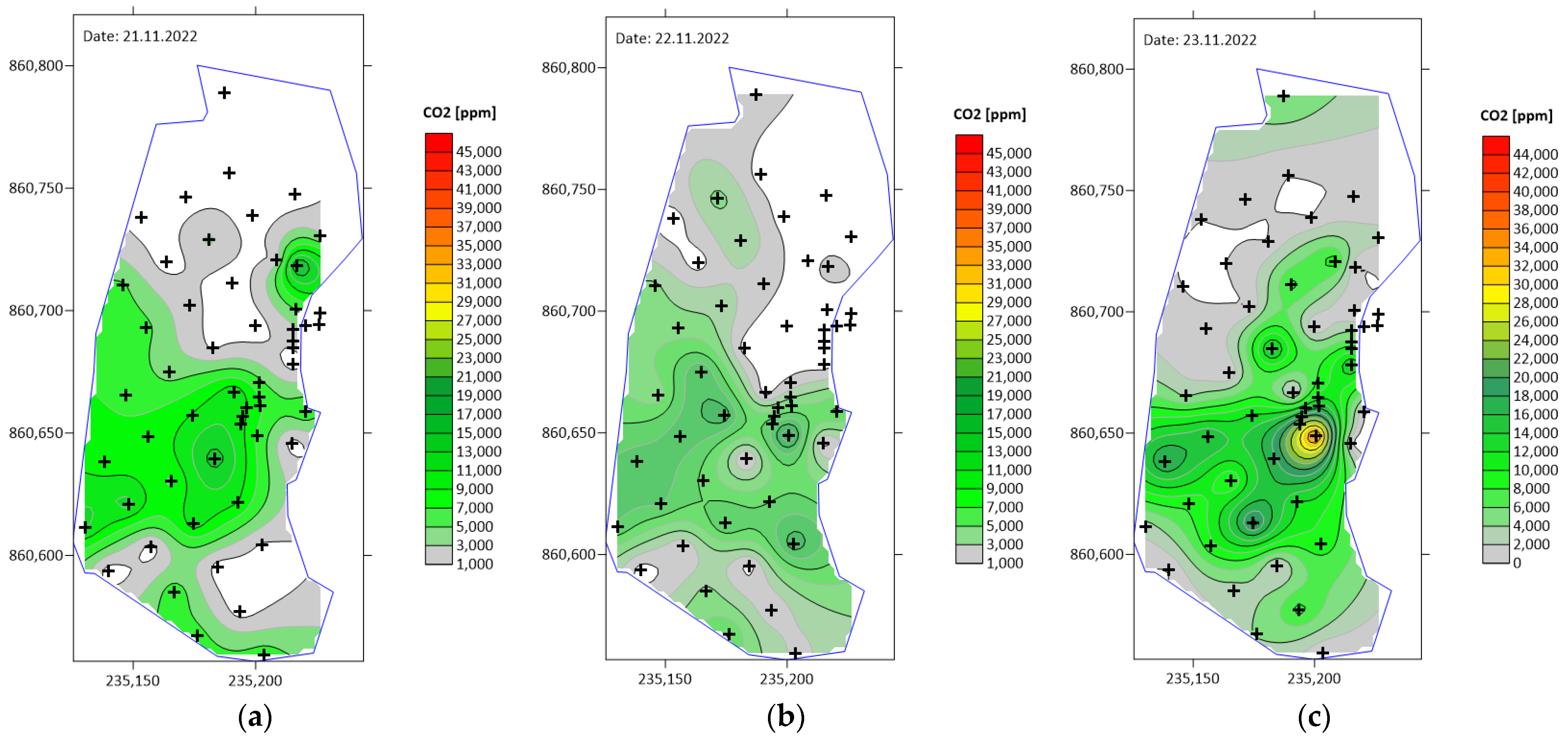



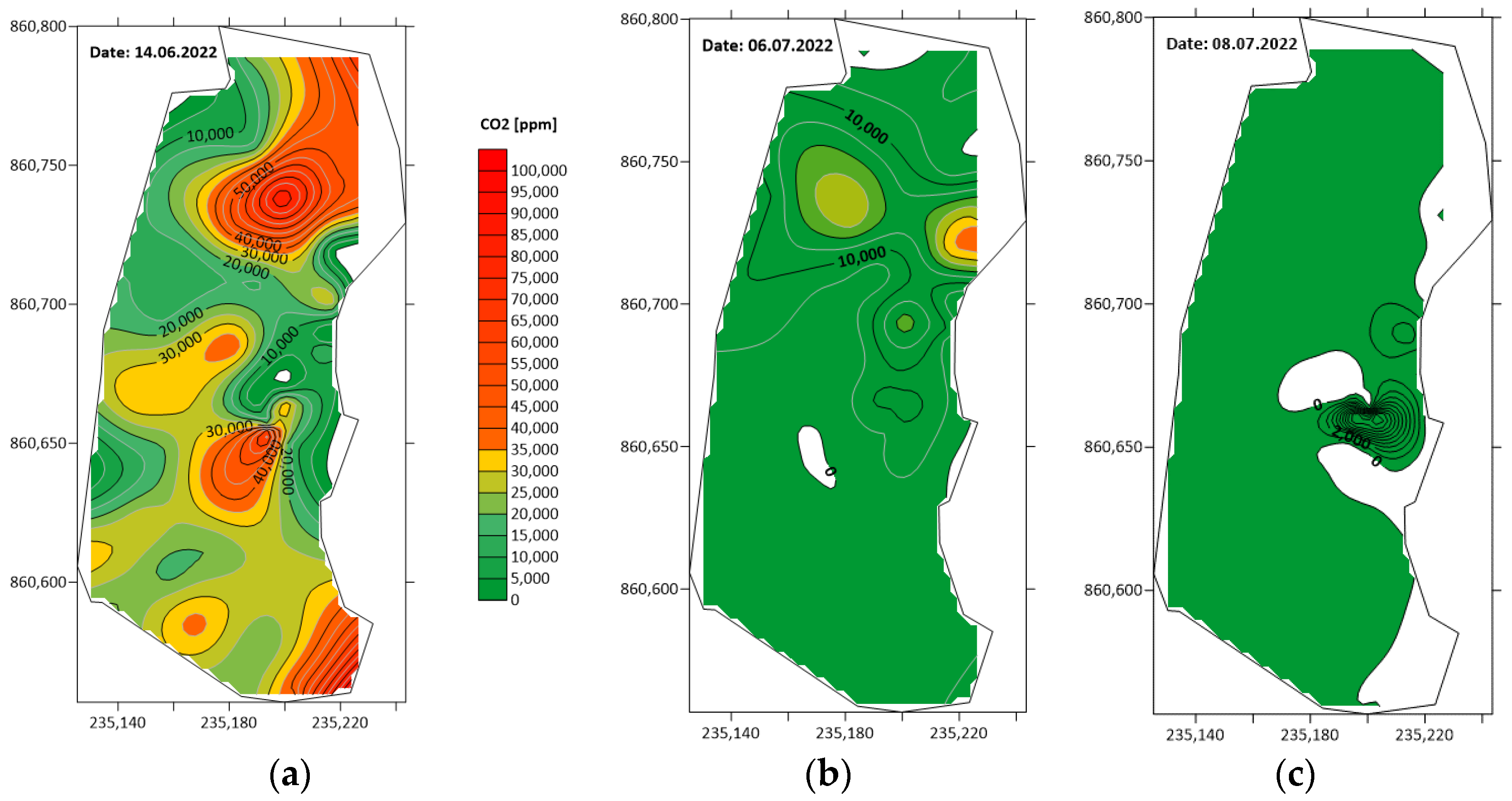
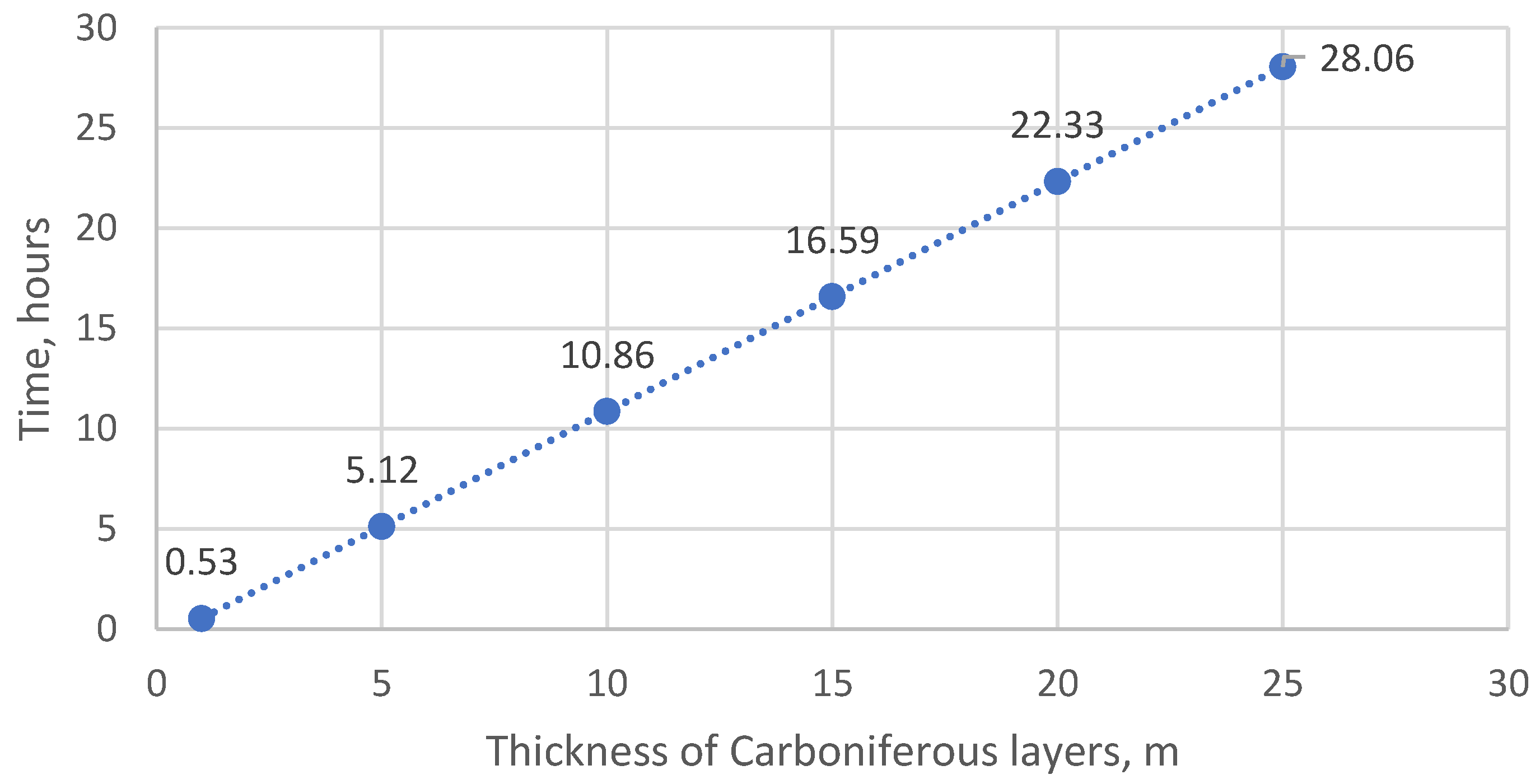

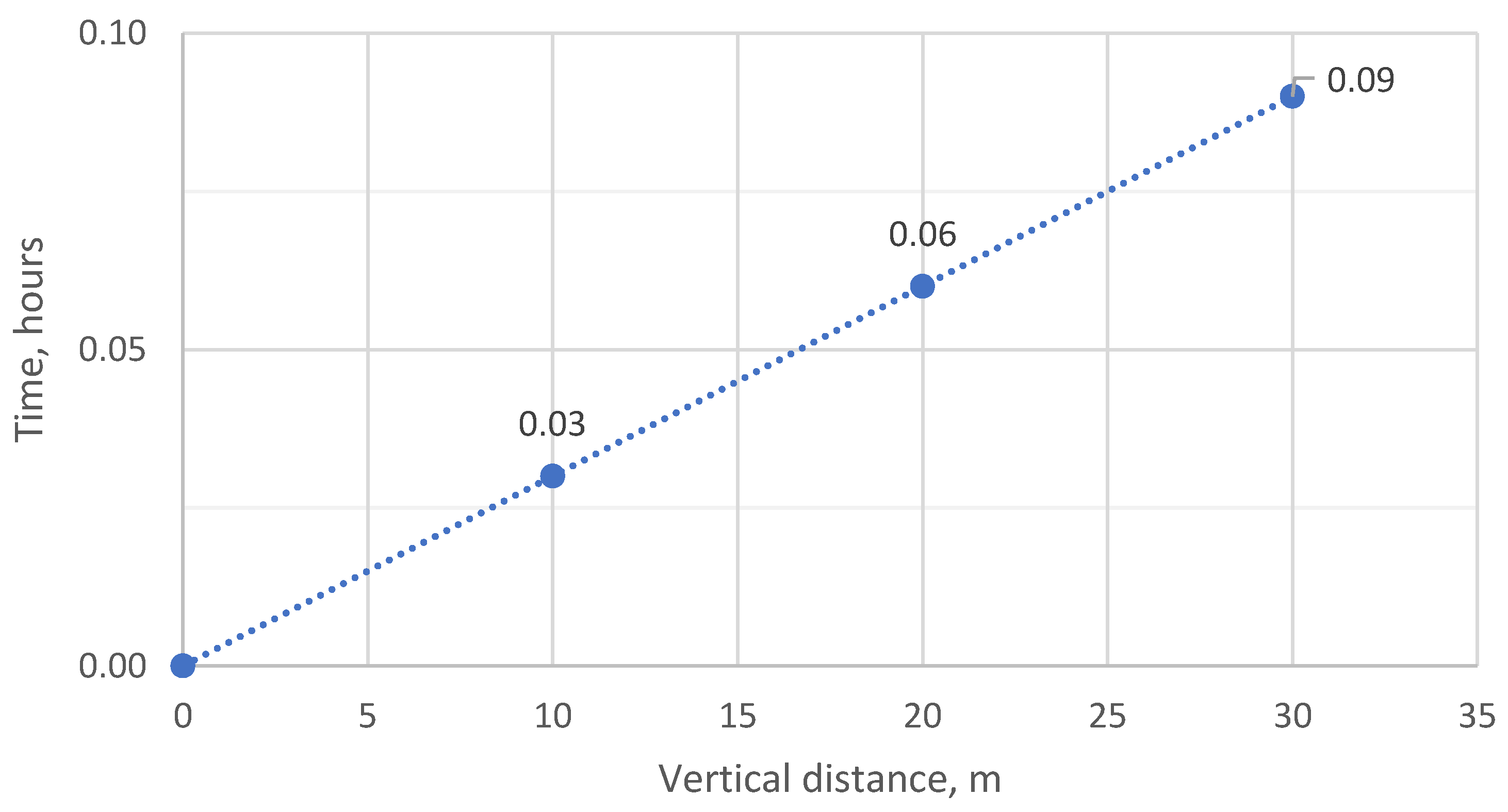
| Parameter | Symbol | Unit | Value | Standard b |
|---|---|---|---|---|
| As received | ||||
| Total moisture | Wt r | (%) | 7.54 | PN-G-04560:1998 [38] |
| Ash | At r | (%) | 4.67 | PN-G-04560:1998 |
| Volatile matter | Vr a | (%) | 33.05 | PN-G-04516:1998 [39] |
| S total | St r | (%) | 0.76 | PN-G-04584:2001 [40] |
| Lower heating value | Q r | (kJ/kg) | 26,684 | PN-G-04513:1981 [41] |
| Analytical | ||||
| Moisture | W a | (%) | 5.06 | PN-G-04560:1998 |
| Ash | A a | (%) | 4.80 | PN-G-04560:1998 |
| Volatile matter | V a | (%) | 33.94 | PN-G-04516:1998 |
| Lower heating value | Q a | (kJ/kg) | 27,617 | PN-G-04513:1981 |
| St a total | (%) | 0.78 | PN-G-04584:2001 | |
| C a | (%) | 71.50 | PN-G-04571:1998 [42] | |
| H a | (%) | 4.71 | PN-G-04571:1998 | |
| N a | (%) | 1.40 | PN-G-04571:1998 | |
| O a,* | (%) | 11.89 |
| Setting | Reducer Pressure | Average Mass Flow | P1 | P2 | P2_2 | MW 1 | MW 2 |
|---|---|---|---|---|---|---|---|
| bar | NL/h | bar | bar | bar | bar | bar | |
| 1 | 1.5 | 1500 | 0.87 | 0.24 | 0.12 | 0.00 | 0.10 |
| 2 | 3.0 | 3000 | 2.23 | 0.56 | 0.14 | 0.00 | 0.12 |
| 3 | 10.5 | 9500 | >5.00 | 2.35 | 0.24 | 0.00 | 0.18 |
| Setting | Reducer Pressure | Average Mass Flow | P1 | P2 | P2_2 | MW 1 | MW 2″ |
|---|---|---|---|---|---|---|---|
| bar | NL/h | bar | bar | bar | bar | bar | |
| 1 | 1.5 | 1600 | 0.85 | 0.24 | 0.12 | 0.00 | 0.00 |
| 2 | 3.0 | 3000 | 2.15 | 0.52 | 0.14 | 0.00 | 0.00 |
| 3 | 9.5 | 9000 | >5.00 | 2.15 | 0.18 | 0.00 | 0.00 |
| Setting | Reducer Pressure | Average Mass Flow | P1 | P2 | P2_2 | MW 1 | MW 2″ | MW 3 | MW 4 |
|---|---|---|---|---|---|---|---|---|---|
| bar | NL/h | bar | bar | bar | bar | bar | bar | bar | |
| 1 | 1.5 | 1600 | 1.05 | 0.28 | 0.12 | 0.00 | 0.00 | 0.00 | 0.00 |
| 2 | 3.0 | 3100 | 2.88 | 0.60 | 0.14 | 0.00 | 0.00 | 0.00 | 0.00 |
| 3 | 8.5 | 7200 | >5.00 | 2.15 | 0.14 | 0.00 | 0.09 | 0.00 | 0.00 |
Disclaimer/Publisher’s Note: The statements, opinions and data contained in all publications are solely those of the individual author(s) and contributor(s) and not of MDPI and/or the editor(s). MDPI and/or the editor(s) disclaim responsibility for any injury to people or property resulting from any ideas, methods, instructions or products referred to in the content. |
© 2023 by the authors. Licensee MDPI, Basel, Switzerland. This article is an open access article distributed under the terms and conditions of the Creative Commons Attribution (CC BY) license (https://creativecommons.org/licenses/by/4.0/).
Share and Cite
Stańczyk, K.; Hildebrandt, R.; Chećko, J.; Urych, T.; Wiatowski, M.; Masum, S.; Sadasivam, S.; Kempka, T.; Otto, C.; Ernst, P.; et al. CO2 Injection via a Horizontal Well into the Coal Seam at the Experimental Mine Barbara in Poland. Energies 2023, 16, 7217. https://doi.org/10.3390/en16207217
Stańczyk K, Hildebrandt R, Chećko J, Urych T, Wiatowski M, Masum S, Sadasivam S, Kempka T, Otto C, Ernst P, et al. CO2 Injection via a Horizontal Well into the Coal Seam at the Experimental Mine Barbara in Poland. Energies. 2023; 16(20):7217. https://doi.org/10.3390/en16207217
Chicago/Turabian StyleStańczyk, Kamil, Robert Hildebrandt, Jarosław Chećko, Tomasz Urych, Marian Wiatowski, Shakil Masum, Sivachidambaram Sadasivam, Thomas Kempka, Christopher Otto, Priscilla Ernst, and et al. 2023. "CO2 Injection via a Horizontal Well into the Coal Seam at the Experimental Mine Barbara in Poland" Energies 16, no. 20: 7217. https://doi.org/10.3390/en16207217
APA StyleStańczyk, K., Hildebrandt, R., Chećko, J., Urych, T., Wiatowski, M., Masum, S., Sadasivam, S., Kempka, T., Otto, C., Ernst, P., & Thomas, H. R. (2023). CO2 Injection via a Horizontal Well into the Coal Seam at the Experimental Mine Barbara in Poland. Energies, 16(20), 7217. https://doi.org/10.3390/en16207217






